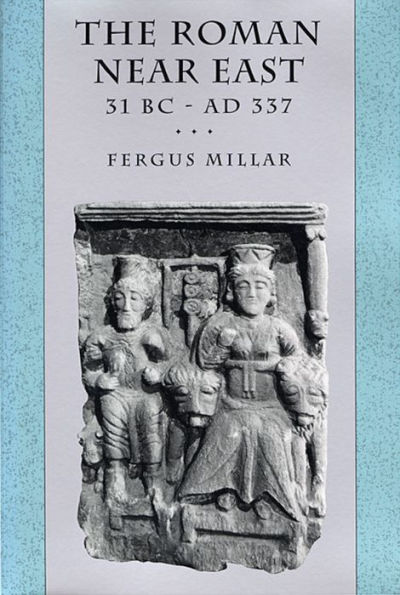

Paperback(Revised ed.)
-
PICK UP IN STORECheck Availability at Nearby Stores
Available within 2 business hours
Related collections and offers
Overview
As Millar traces the advance of Roman control, he gives a lucid picture of Rome’s policies and governance over its far-flung empire. He introduces us to major regions of the area and their contrasting communities, bringing out the different strands of culture, communal identity, language, and religious belief in each. The Roman Near East makes it possible to see rabbinic Judaism, early Christianity, and eventually the origins of Islam against the matrix of societies in which they were formed. Millar’s evidence permits us to assess whether the Near East is best seen as a regional variant of Graeco-Roman culture or as in some true sense oriental.
A masterful treatment of a complex period and world, distilling a vast amount of literary, documentary, artistic, and archaeological evidence—always reflecting new findings—this book is sure to become the standard source for anyone interested in the Roman Empire or the history of the Near East.

Product Details
| ISBN-13: | 9780674778863 |
|---|---|
| Publisher: | Harvard University Press |
| Publication date: | 03/15/1995 |
| Series: | Carl Newell Jackson Lectures , #6 |
| Edition description: | Revised ed. |
| Pages: | 624 |
| Product dimensions: | 6.38(w) x 9.25(h) x 1.30(d) |
| Lexile: | 1620L (what's this?) |
About the Author
Table of Contents
Preface
Abbreviations
1. Prologue: In Search of the Orient
I. Empire
2. The Bridgehead and the Dependent Kingdoms, 31 BC-AD 74
2.1. From the Battle of Actium to the Death of Herod the Great
2.2. From the Death of Herod the Great to the End of Tiberius' Reign
2.3. From the Reign of Gaius to the Outbreak of the Jewish War
2.4. The Jewish War and Its Aftermath
3. Imperialism and Expansion, AD 74-195
3.1. Vespasian: A New Near Eastern Empire
3.2. Trajan : Expansion and Rearrangement in the Southern Near East
3.3. The Roman Presence, AD 114-161
3.4. Emperors and Pretenders in the Near East from Lucius Verus to Septimius Severus: The Conquest of Mesopotamia
4. Rome And Mesopotamia: From Parthia To Persia
4.1. The Severan Near East as a Military Structure
4.2. Emperors on Campaign, from Caracalla to Philip the Arab Shapur's Invasions and the Empire of Palmyra, AD 252-273
5. The Tetrarchy and Constantine
5.1. The Tetrarchy: Persian Wars and Fortified Lines
5.2. The Near East in the Tetrarchic Empire, AD 284-312
5.3. Licinius and Constantine, AD 313-337: Retrospect from a Christianised Empire
II. Regions and Communities
6. Communal and Cultural Identities
7. The Tetrapolis and Northern Syria
7.1. The Geographical Context
7.2. Local Cult-Centres: Hierapolis and Doliche
7.3. Villages and Rural Temples
7.4. The Major Cities: Apamea
8. The Phoenician Coast and ItsHinterland
8.1. History and Geography
8.2. Phoenicia: The Southern Region
8.3. The Northern Coastline and Its Hinterland
8.4. The Major Cities: Byblos and Berytus
8.5. Sidon and Tyre
9. Eastern Syria Phoenice: Mountain, Oasis and Steppe
9.1. Geographical Connections
9.2. Emesa and Elagabal
9.3. Damascus and Its Region Palmyra
10. From Judaea to Syria Palaestina
10.1. History, Religion and Geography
10.2. Judaea before the First Revolt
10.3. From the First Jewish Revolt to the Second
10.4. Syria Palaestina
11. Arabia
11.1. Regions and Cultures
11.2. The Kingdom of Nabataea
11.3. The Decapolis in the First Century
11.4. The New Province of Arabia
11.5. The Nomadic Presence
12. The Euphrates and Mesopotamia
12.1. Geography, Culture and Language
12.2. Dura-Europos in the Parthian Period
12.3. The Middle Euphrates and the Coming of Rome
12.4. Roman Dura-Europos
12.5. Edessa as a Kingdom and Roman Colony until the Middle of the Third Century
12.6. Social and Religious Currents in the Fourth Century
13. Epilogue: East and West
13.1. East?
13.2. West?
Appendix A. The Inscriptions of the Tetrarchic Land-Surveyors
Appendix B. Documents from the Bar Kochba War
Appendix C. Materials for the History of Roman Edessa and Osrhoene, AD 163-337
Maps
I. The Near East: Areas Covered by Maps II-XII
II. The Roman Near East: Main Sites and Geographical Features
III. Northwestern Syria and Mount Amanus
IV. The Phoenician Coast and Western Syria Phoenice
V. The Central Syrian Steppe, Pabnyra and the Euphrates
VI. Judaea/Syria Palaestina, Western Arabia
VII. Southeastern Syria Phoenice, Northern Arabia
VIII. Petra and South-Central Arabia
IX. Arabia, with Sinai, the Red Sea and the Hedjaz
X. Eastern Syria, the Euphrates and Western Mesopotamia
XI. Central Mesopotamia and Mons Masius
XII. The Eastern Syrian Steppe and the Middle Euphrates
General Index
Index of Literary Sources
Index of Documents
What People are Saying About This
This work has been long awaited and will fill a very great need. It is an authoritative synoptic view of the entire Roman Near East, with reference to the most important recent discussions and discoveries.
This work has been long awaited and will fill a very great need. It is an authoritative synoptic view of the entire Roman Near East, with reference to the most important recent discussions and discoveries.
— G. W. Bowersock, Institute for Advanced Study, Princeton
